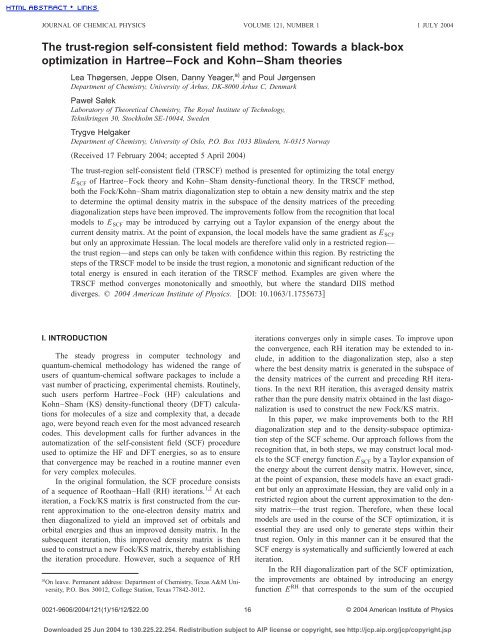Get my PhD Thesis
Get my PhD Thesis
Get my PhD Thesis
You also want an ePaper? Increase the reach of your titles
YUMPU automatically turns print PDFs into web optimized ePapers that Google loves.
JOURNAL OF CHEMICAL PHYSICS VOLUME 121, NUMBER 1 1 JULY 2004<br />
The trust-region self-consistent field method: Towards a black-box<br />
optimization in Hartree–Fock and Kohn–Sham theories<br />
Lea Thøgersen, Jeppe Olsen, Danny Yeager, a) and Poul Jørgensen<br />
Department of Chemistry, University of Århus, DK-8000 Århus C, Denmark<br />
Paweł Sałek<br />
Laboratory of Theoretical Chemistry, The Royal Institute of Technology,<br />
Teknikringen 30, Stockholm SE-10044, Sweden<br />
Trygve Helgaker<br />
Department of Chemistry, University of Oslo, P.O. Box 1033 Blindern, N-0315 Norway<br />
Received 17 February 2004; accepted 5 April 2004<br />
The trust-region self-consistent field TRSCF method is presented for optimizing the total energy<br />
E SCF of Hartree–Fock theory and Kohn–Sham density-functional theory. In the TRSCF method,<br />
both the Fock/Kohn–Sham matrix diagonalization step to obtain a new density matrix and the step<br />
to determine the optimal density matrix in the subspace of the density matrices of the preceding<br />
diagonalization steps have been improved. The improvements follow from the recognition that local<br />
models to E SCF may be introduced by carrying out a Taylor expansion of the energy about the<br />
current density matrix. At the point of expansion, the local models have the same gradient as E SCF<br />
but only an approximate Hessian. The local models are therefore valid only in a restricted region—<br />
the trust region—and steps can only be taken with confidence within this region. By restricting the<br />
steps of the TRSCF model to be inside the trust region, a monotonic and significant reduction of the<br />
total energy is ensured in each iteration of the TRSCF method. Examples are given where the<br />
TRSCF method converges monotonically and smoothly, but where the standard DIIS method<br />
diverges. © 2004 American Institute of Physics. DOI: 10.1063/1.1755673<br />
I. INTRODUCTION<br />
The steady progress in computer technology and<br />
quantum-chemical methodology has widened the range of<br />
users of quantum-chemical software packages to include a<br />
vast number of practicing, experimental chemists. Routinely,<br />
such users perform Hartree–Fock HF calculations and<br />
Kohn–Sham KS density-functional theory DFT calculations<br />
for molecules of a size and complexity that, a decade<br />
ago, were beyond reach even for the most advanced research<br />
codes. This development calls for further advances in the<br />
automatization of the self-consistent field SCF procedure<br />
used to optimize the HF and DFT energies, so as to ensure<br />
that convergence may be reached in a routine manner even<br />
for very complex molecules.<br />
In the original formulation, the SCF procedure consists<br />
of a sequence of Roothaan–Hall RH iterations. 1,2 At each<br />
iteration, a Fock/KS matrix is first constructed from the current<br />
approximation to the one-electron density matrix and<br />
then diagonalized to yield an improved set of orbitals and<br />
orbital energies and thus an improved density matrix. In the<br />
subsequent iteration, this improved density matrix is then<br />
used to construct a new Fock/KS matrix, thereby establishing<br />
the iteration procedure. However, such a sequence of RH<br />
a On leave. Permanent address: Department of Chemistry, Texas A&M University,<br />
P.O. Box 30012, College Station, Texas 77842-3012.<br />
iterations converges only in simple cases. To improve upon<br />
the convergence, each RH iteration may be extended to include,<br />
in addition to the diagonalization step, also a step<br />
where the best density matrix is generated in the subspace of<br />
the density matrices of the current and preceding RH iterations.<br />
In the next RH iteration, this averaged density matrix<br />
rather than the pure density matrix obtained in the last diagonalization<br />
is used to construct the new Fock/KS matrix.<br />
In this paper, we make improvements both to the RH<br />
diagonalization step and to the density-subspace optimization<br />
step of the SCF scheme. Our approach follows from the<br />
recognition that, in both steps, we may construct local models<br />
to the SCF energy function E SCF by a Taylor expansion of<br />
the energy about the current density matrix. However, since,<br />
at the point of expansion, these models have an exact gradient<br />
but only an approximate Hessian, they are valid only in a<br />
restricted region about the current approximation to the density<br />
matrix—the trust region. Therefore, when these local<br />
models are used in the course of the SCF optimization, it is<br />
essential they are used only to generate steps within their<br />
trust region. Only in this manner can it be ensured that the<br />
SCF energy is systematically and sufficiently lowered at each<br />
iteration.<br />
In the RH diagonalization part of the SCF optimization,<br />
the improvements are obtained by introducing an energy<br />
function E RH that corresponds to the sum of the occupied<br />
0021-9606/2004/121(1)/16/12/$22.00 16<br />
© 2004 American Institute of Physics<br />
Downloaded 25 Jun 2004 to 130.225.22.254. Redistribution subject to AIP license or copyright, see http://jcp.aip.org/jcp/copyright.jsp

















